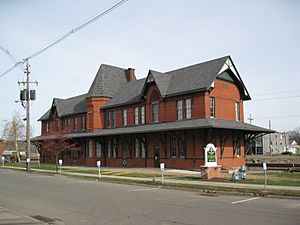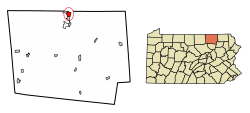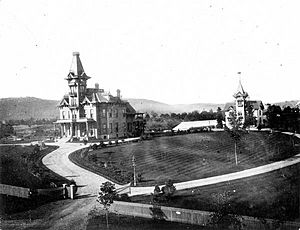Sayre, Pennsylvania facts for kids
Quick facts for kids
Sayre, Pennsylvania
|
|
|---|---|
|
Borough
|
|

Sayre Historical Society Museum
|
|

Location of Sayre in Bradford County, Pennsylvania.
|
|
| Country | United States |
| State | Pennsylvania |
| County | Bradford |
| Settled | 1871 |
| Incorporated (borough) | 1891 |
| Area | |
| • Total | 2.04 sq mi (5.27 km2) |
| • Land | 2.02 sq mi (5.24 km2) |
| • Water | 0.01 sq mi (0.04 km2) |
| Elevation | 771 ft (235 m) |
| Population
(2010)
|
|
| • Total | 5,587 |
| • Estimate
(2019)
|
5,366 |
| • Density | 2,653.81/sq mi (1,024.64/km2) |
| Time zone | UTC-5 (Eastern (EST)) |
| • Summer (DST) | UTC-4 (EDT) |
| Zip code |
18840
|
| Area code(s) | 570 Exchanges: 882,886,887,888 |
| FIPS code | 42-68096 |
Sayre is a borough in Bradford County, Pennsylvania. The largest in the county, it is the principal city in the Sayre, PA Micropolitan Statistical Area. It lies 18 miles southeast of Elmira, New York, and 30 miles southwest of Binghamton, New York. In the past, various iron products were made there. In 1900, 5,243 people lived there; in 1910, 6,426 people lived there, and in 1940, 7,569 persons made their homes in Sayre. The population was 5,587 at the 2010 census.
Sayre is part of the Penn-York Valley ("The Valley"), a group of four contiguous communities in New York and Pennsylvania: Waverly, New York; South Waverly, Pennsylvania; Sayre; Athens, Pennsylvania, and smaller surrounding communities with a combined population near 35,000.
Contents
History
In May 1870, a Waverly banker named Howard Elmer, along with Charles Anthony and James Fritcher, bought the Pine Plains area between Waverly and Athens. Elmer convinced Asa Packer to locate a new railroad repair facility on the Pine Plains for the expanding Lehigh Valley Railroad, which was making a push north to connect to the Erie Railroad at Waverly. Robert Heysham Sayre, president of the Pennsylvania and New York Railroad, helped cement the deal. The town was named in his honor. Sayre was incorporated on January 27, 1891.
In 1904 when the locomotive shops were built at Sayre, the main shop building was believed to be the largest structure in the world under one roof, but held that title for only a brief time. The railroad operated from 1870 until 1976, but maintenance facilities were shifted away before that. With the decline of industry, population has declined since 1940.
Geography
Sayre is located at 41°59′1″N 76°31′15″W / 41.98361°N 76.52083°W (41.983567, -76.520845) in a river valley in the Allegheny Plateau just north of the confluence of the Susquehanna River and the Chemung River, along with Athens, Pennsylvania, South Waverly, Pennsylvania, and Waverly, New York. Together, these small towns make up the greater area known as the Penn-York Valley, or just "the Valley". The New York / Pennsylvania border cuts through the valley. There is no physical border between the towns, as the grid of streets and avenues blend seamlessly from one town to another. Sayre is bounded on the east and west by Athens Township, on the south by the borough of Athens, on the northwest by South Waverly, and on the north by Waverly, New York.
Pennsylvania Route 199 passes through the borough as Keystone Avenue, Mohawk Street, and Spring Street, ending at Interstate 86 just over the state line in Waverly, New York. Via I-86 it is 17 miles (27 km) northwest to Elmira, New York, and by New York State Route 17 (future I-86) it is 38 miles (61 km) east to Binghamton, New York.
According to the United States Census Bureau, the borough has a total area of 2.03 square miles (5.27 km2). 2.02 square miles (5.24 km2) of it is land and 0.02 square miles (0.04 km2), or 0.67%, is water.
Demographics
| Historical population | |||
|---|---|---|---|
| Census | Pop. | %± | |
| 1880 | 729 | — | |
| 1900 | 5,243 | — | |
| 1910 | 6,426 | 22.6% | |
| 1920 | 8,078 | 25.7% | |
| 1930 | 7,902 | −2.2% | |
| 1940 | 7,569 | −4.2% | |
| 1950 | 7,735 | 2.2% | |
| 1960 | 7,917 | 2.4% | |
| 1970 | 7,473 | −5.6% | |
| 1980 | 6,951 | −7.0% | |
| 1990 | 5,791 | −16.7% | |
| 2000 | 5,813 | 0.4% | |
| 2010 | 5,587 | −3.9% | |
| 2019 (est.) | 5,366 | −4.0% | |
| Sources: | |||
2010
At the 2010 census there were 5,587 people, 2,479 households, and 1,394 families living in the borough. The population density was 2,793.5 people per square mile (1,091.2/km²). There were 2,693 housing units at an average density of 1,346.5 per square mile (526/km²). The racial makeup of the borough was 96% White, 0.8% African American, 0.3% Native American, 1.7% Asian, 0.2% from other races, and 1% from two or more races. Hispanic or Latino of any race were 1.1%.
There were 2,479 households, 27.3% had children under the age of 18 living with them, 39.9% were married couples living together, 11.7% had a female householder with no husband present, and 43.8% were non-families. 37.3% of households were made up of individuals, and 16% were one person aged 65 or older. The average household size was 2.23 and the average family size was 2.94.
The age distribution was 22.8% under the age of 18, 60.1% from 18 to 64, and 17.1% 65 or older. The median age was 41 years.
The median household income was $34,221 and the median family income was $57,256. Males had a median income of $41,895 versus $27,816 for females. The per capita income for the borough was $20,956. About 6.6% of families and 11.7% of the population were below the poverty line, including 16.9% of those under age 18 and 5.3% of those age 65 or over.
2000
At the 2000 census there were 5,813 people, 2,529 households, and 1,514 families living in the borough. The population density was 2,866.8 people per square mile (1,105.6/km²). There were 2,722 housing units at an average density of 1,342.4 per square mile (517.7/km²). The racial makeup of the borough was 96.92% White, 0.62% African American, 0.17% Native American, 1.26% Asian, 0.15% from other races, and 0.88% from two or more races. Hispanic or Latino of any race were 0.71%.
There were 2,529 households, 26.9% had children under the age of 18 living with them, 43.9% were married couples living together, 11.9% had a female householder with no husband present, and 40.1% were non-families. 35.6% of households were made up of individuals, and 16.2% were one person aged 65 or older. The average household size was 2.28 and the average family size was 2.96.
The age distribution was 23.9% under the age of 18, 7.8% from 18 to 24, 28.2% from 25 to 44, 21.9% from 45 to 64, and 18.3% 65 or older. The median age was 39 years. For every 100 females there were 85.7 males. For every 100 females age 18 and over, there were 82.0 males.
The median household income was $33,338 and the median family income was $40,571. Males had a median income of $30,685 versus $24,837 for females. The per capita income for the borough was $18,549. About 7.1% of families and 9.1% of the population were below the poverty line, including 8.7% of those under age 18 and 8.4% of those age 65 or over.
Transportation
Sayre has one bus service, BeST Transit. BeST Transit makes numerous stops in Waverly, Sayre, and Athens and provides service to Towanda, Wysox, Troy, Canton, and the Lycoming Mall. Sayre and The Valley also have taxi service available through Valley Taxi. Pennsylvania Route 199 connects Sayre to Athens and Waverly.
Community

Sayre is home to the Robert Packer Hospital and Guthrie Clinic.
Community organizations:
- Sayre Little League
- Sayre Recreation Program
- Big Brothers/Big Sisters
- 4H
- Community Service Club
- Sayre Library
Horned giants
The "horned giants" of Sayre is an urban legend concerning a series of skeletons that included a horned skull reportedly discovered during the 1880s by the then-state historian, Dr. G.P. Donehoo, and two visiting professors, A.B. Skinner and W.K. Moorehead while excavating a burial mound. The skeletons were reported to be at or above 7 feet (2.1 m) in height, possessing skulls that had horn-like protuberances just above the eyebrows, but were claimed to have been lost, misplaced, or stolen while in route to the American Investigation Museum. Neither Donehoo, Skinner, nor Moorehead described the discovery of any human skeletons at Sayre exhibiting gigantism or horned protrusions in their official excavation reports
Education
Children residing in the borough are assigned to attend the Sayre Area School District.
Notable people
- Further information:
- Arcesia (John Anthony Arcesi), jazz singer
- Chuck Ciprich, race car driver
- Colleen Dominguez, ESPN reporter
- Peter Cacchione, communist labor leader who served on the New York City Council
- Donnie Guthrie, physician
- Cabot Lyford, sculptor born in Sayre in 1925
- Red Murray, baseball player
- Erwin Rudolph, billiards player
- Robert S. Smith, priest
- Jeff Terpko, baseball player
See also
 In Spanish: Sayre (Pensilvania) para niños
In Spanish: Sayre (Pensilvania) para niños



